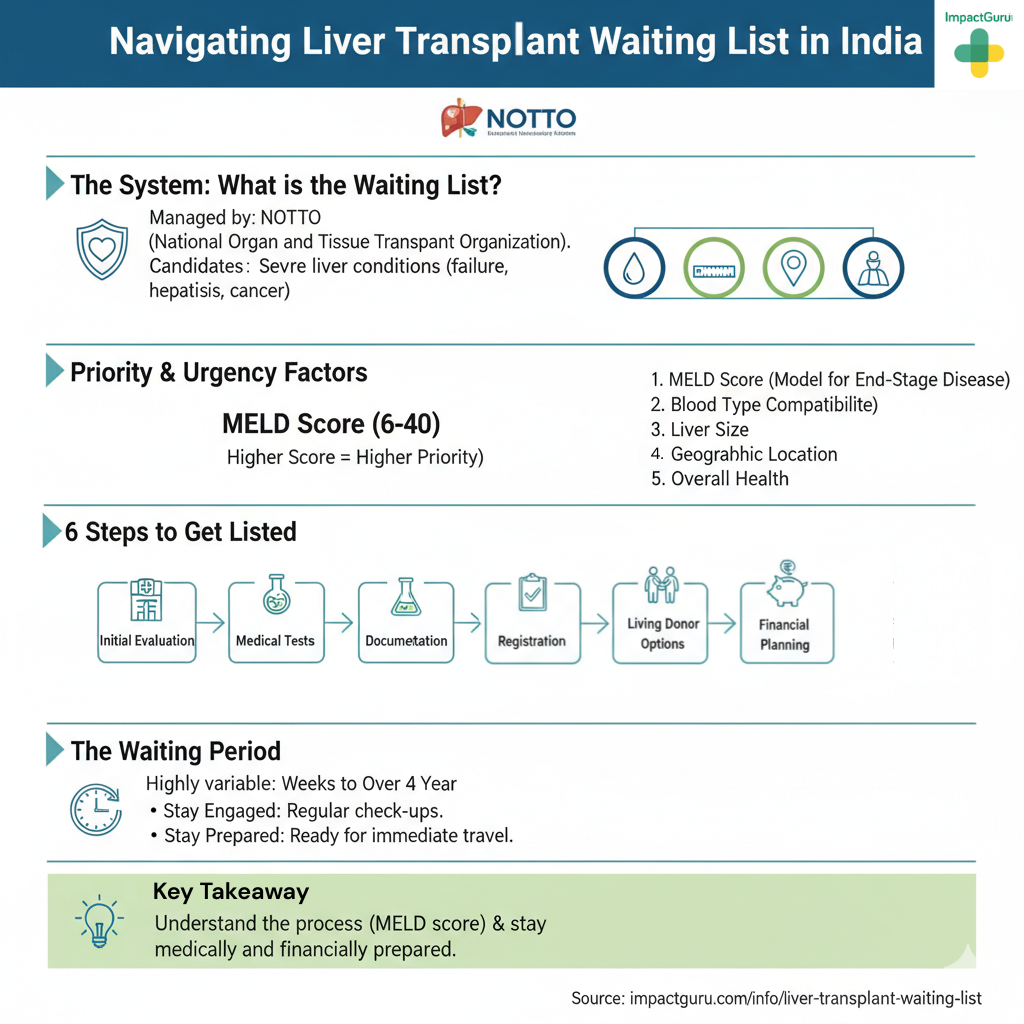Waiting for a life-saving liver transplant isn’t just a test of time; it’s a race against it. Across India, thousands of patients are placed on the liver transplant waiting list, hoping for that one call that could change everything. But how long is the liver wait? What determines your spot on the liver transplant waiting list? And is there anything you can do to speed it up?
Getting on the liver transplant waiting list in India involves strict medical criteria, multiple evaluations, and often, long periods of uncertainty. As medical science advances, the gap between liver transplant demand and donor availability remains wide. That’s why many families turn to trusted crowdfunding platforms like ImpactGuru to prepare financially and emotionally for what lies ahead.
Read More: Benefits of Organ Donation: Criteria & Registration Process
Table of Contents
What is the Liver Transplant Waiting List?
The liver transplant waiting list is a system that matches patients with donated livers based on urgency and compatibility. In India, it is managed by NOTTO (National Organ and Tissue Transplant Organization) and supported by the National Organ Transplant Program (NOTP).
People with severe liver conditions, such as liver failure, hepatitis, certain liver cancers, or inherited diseases, may be added to the list after a full medical evaluation.
This evaluation includes blood tests, imaging scans, and a review of the patient’s health history. It helps the transplant team decide if a liver transplant is the right option.
Once approved, a patient is assigned a MELD score (Model for End-Stage Liver Disease). This score, based on blood test results, shows how urgently a person needs a transplant. Higher MELD scores mean higher priority on the waiting list.
Read more: Find Hospitals near you.
Read more: Calculate the Cost of your Treatment.

But urgency isn’t the only factor. The liver weight also depends on:
- Blood type compatibility
- Size of the donor’s liver
- The patient’s overall health
- How close the patient is to the hospital where the organ becomes available
Some patients may avoid the waiting list if a suitable living donor is available. However, they must still meet the required liver transplant donor criteria.
Because donor organs are limited in India, many patients wait for weeks or even months. During this time, families often turn to crowdfunding websites like Impact Guru to raise money online for managing high medical expenses and staying prepared.
Read More: How to Become a Kidney Transplant Donor in India?
Being on the waiting list is not passive. Patients must:
- Stay in close contact with their transplant team
- Go for regular checkups.
- Be ready to travel quickly when a liver becomes available
This stage is challenging but critical, and understanding how the waiting list works can make the process easier to navigate.
What are the Factors Influencing Your Position on the Waiting List?
The time a patient spends on the liver transplant waiting list in India can vary widely. Some people get a liver within weeks. Others may wait for months, or even longer.
Several factors influence your liver wait time and your position on the list. Understanding these can help you and your family stay informed and prepared.
1. MELD Score (Model for End-Stage Liver Disease)
This score plays the biggest role. It is calculated using three blood test results:
- Serum bilirubin (how well the liver clears waste)
- Serum creatinine (kidney function)
- INR (blood’s ability to clot)
The MELD score ranges from 6 to 40. A higher score means more severe liver disease and a higher priority for a transplant.
2. Blood Type Compatibility
Another factor is that your blood type must match the donor’s. If your blood type is rare, your wait might be longer.
3. Size of the Donor Liver
The donor liver size must match your body size for the transplant to be successful. This is why doctors consider your liver size and normal liver weight during evaluation.
4. Geographic Location
Organs are allocated based on proximity. Patients closer to the hospital where the liver becomes available are more likely to receive the call in time. This helps reduce organ transport time and risks.
5. Overall Health Condition
Doctors also assess whether a patient is physically fit to undergo transplant surgery. If your health worsens, your position may change, or you may be temporarily removed from the list until stable.
6. Availability of a Living Donor
If a living donor is ready and eligible, you may not have to wait for a deceased donor. This can shorten your wait time, but both donor and recipient must meet specific liver transplant donor criteria, and there should be no monetary benefit of organ donation.
What to Expect
There’s no fixed timeline. Some patients wait just a few weeks. Others remain on the list for over a year, especially in states where donor organs are scarce.
That’s why getting regular check-ups and maintaining contact with your transplant center are so important.

How to Register and Get on a Liver Transplant Waiting List?
Getting listed for a liver transplant in India involves a structured process. It ensures only eligible and prepared patients are added to the list. Here’s a step-by-step overview of how to register:
1. Get Evaluated by a Transplant Hospital
First, you need to visit a government-authorized liver transplant hospital. The transplant team will evaluate:
- Your liver function
- Underlying liver disease
- Overall health and suitability for surgery
They may also assess other organ functions, especially the kidneys, which is why many patients also explore kidney transplant donor options if needed.
2. Complete Required Medical Tests
You’ll undergo tests including:
- Blood tests (for MELD score and compatibility)
- Imaging (CT scan, ultrasound)
- Cardiac evaluation
Doctors will also measure your liver size and weight to plan the transplant appropriately.
3. Submit Documents and Medical Reports
Once the evaluation is done, your case will be submitted to the regional organ-sharing network (like NOTTO, ROTTO, or SOTTO), depending on your location. You’ll need:
- Identity proof
- Medical records
- Evaluation summary
- Consent forms
4. Registration with the State Transplant Authority
Your hospital will forward your case to the state organ allocation system. Once approved, your name goes on the liver transplant waiting list. Your liver wait time begins from this point, and your position depends on urgency and MELD score.
5. Explore Living Donor Options (If Available)
If a living donor steps forward, doctors will assess them based on liver transplant donor criteria. A suitable living donor can reduce your waiting time significantly.
6. Financial Planning and Support
Liver transplants can be costly; thus, some families turn to medical fundraising platforms like Impact Guru to manage expenses. It’s important to explore insurance, government schemes, or donation-based help early on.
Once listed, you will be monitored regularly. If your condition changes, your priority on the liver transplant waiting list in India may also shift. Stay in touch with your transplant coordinator and update them on any health changes.
Conclusion
Being on the liver transplant waiting list requires staying medically eligible, emotionally strong, and financially supported. This is because your place on the list depends on several factors, including your MELD score, how advanced your liver disease is, and the availability of matching donors. While you may not control every variable, understanding the process puts you in a stronger position to navigate it.
In a country where the demand far exceeds the donor supply, increasing awareness about body part donation can help bridge this gap and save more lives.
For families facing rising medical costs, crowdfunding platforms in India, like ImpactGuru Foundation, offer financial relief through online donation India options, giving patients a better chance at timely treatment.
FAQs
A patient must undergo a full medical evaluation at a recognized transplant centre, including tests like liver/kidney function, disease severity (e.g. MELD score), and overall fitness for surgery.
Patients are prioritized based on factors like how severe their liver disease is (MELD), blood type match, time spent waiting, and overall health condition.
Wait times can vary widely—from several weeks to many months or even years—depending on organ availability, urgency, matching, and regional factors.
The transplant team contacts the patient immediately, performs last-minute evaluations, and if the organ is suitable, proceeds with the transplant.
Yes — having a willing, compatible living donor often shortens wait time compared to relying solely on deceased donor organs.
The liver transplant waiting list in India is a system managed by the National Organ and Tissue Transplant Organization (NOTTO) that matches patients with donated livers based on urgency and compatibility.












